Class 6 Social Science Chapter 2 Oceans and Continents Questions Answers
Class 6 Social Science Chapter 2 Oceans and Continents Questions Answers offer detailed and simplified answers to all the questions provided in the Chapter 2 Oceans and Continents. These solutions are a good source of study material for the students and help them secure better marks in their examinations. This chapter discusses two major landforms: oceans and continents, and their role in shaping the world’s geography. The chapter also explains the effect of oceans in changing the climate and sustaining life on Earth.
Download Class 6 Social Science Chapter 2 Oceans and Continents Questions Answers PDF
The Big Questions (Page 27)
1. What are oceans and continents? What are their names and their distribution?
Answer:
Oceans are the largest saltwater bodies, covering three-fourths of the Earth’s surface. Continents are large, continuous expanses of land separated by water bodies and cover a little over one-fourth of the Earth’s surface.
Oceans: The Pacific Ocean, the Atlantic Ocean, the Indian Ocean, the Arctic Ocean, and the Southern (or Antarctic) Ocean.
Continent: Asia, Africa, North America, South America, Antarctica, Europe, and Australia.
2. In what ways do oceans and continents impact life on Earth, including human life?
Answer:
Oceans play a crucial role in maintaining the Earth’s climate by influencing weather patterns and generating rainfall. They sustain life on Earth by producing oxygen, providing trade routes, and serving as a vital food source through fishing.
Continents provide habitats for plants, animals, and humans. They are also rich sources of minerals, freshwater, and forests, which support both ecological balance and human development.
Let’s Explore (Page 29)
1. What are the circular lines in each map called? And do you know what the lines radiating out of the two poles are called? (Hint: you studied them in the previous chapter, but here they are presented differently.)
Answer:
The circular lines that run across the globe parallel to the equator are known as parallels of latitude. The lines that radiate from the two poles and run from the North Pole to the South Pole are called meridians of longitude. Together, they help determine and identify the exact location of a place on Earth.
2. Which hemisphere holds more water?
Answer:
The Southern Hemisphere contains more water than the Northern Hemisphere.
3. What do you think could be the approximate proportion of water to land in the Northern Hemisphere? And in the Southern Hemisphere? Discuss in groups.
Answer:
The Northern Hemisphere consists of approximately 60% land and 40% water, making it more land-dominated. In contrast, the Southern Hemisphere contains about 80% water and 20% land, which is why it is often referred to as more oceanic.
4. Are all the oceans connected with one another, or are there separations between them?
Answer:
All oceans are interconnected and not truly separated. The boundaries between them that appear on maps are simply human-made conventions.
Think About It (Page 31)
1. If there is such abundance of water on the planet, why is there so much talk of ‘water scarcity’ or a ‘water crisis’?
Answer:
Although there is an abundance of water on the planet, most of it is stored in the oceans and is salty, making it unfit for human consumption. Freshwater makes up only a small fraction of the Earth’s total water supply and is found in glaciers, lakes, rivers, and underground sources. This limited availability of accessible freshwater leads to issues of water scarcity or a water crisis.
2. What ways of saving water are you aware of? Which ones have you seen practised at home, at your school, and in your village, town or city?
Answer:
Some convenient and efficient ways to save water include:
(i) Turning off taps when not in use.
(ii) Fixing leaking pipes and taps promptly.
(iii) Using rainwater for gardening and cleaning.
(iv) Using water-efficient appliances and reusing water where possible.
At home: In our family, we make sure to turn off taps when not in use and fix any leaks to prevent water wastage.
At school: Teachers encourage us not to waste water in the washrooms and to report any leaking taps.
In the city: I have seen water harvesting systems installed in some buildings and houses to help conserve water.
Let’s Explore (Page 32)
1. Locate the five oceans and, in the table below, mark the hemisphere or hemispheres they belong to.
Northern Hemisphere | Southern Hemisphere | |
Pacific Ocean | ||
Atlantic Ocean | ||
Indian Ocean | ||
Southern Ocean | ||
Arctic Ocean |
Answer:
Northern Hemisphere | Southern Hemisphere | |
Pacific Ocean | Yes | Yes |
Atlantic Ocean | Yes | Yes |
Indian Ocean | No | Yes |
Southern Ocean | No | Yes |
Arctic Ocean | Yes | No |
Let’s Explore (Page 36)

1. Counting the numbers of squares, name the largest continent and the smallest.
Answer:
Largest continent – Asia.
Smallest continent – Australia.
2. Which one is larger — North America or South America? Africa or North America? Antarctica or Australia?
Answer:
North America or South America – North America is larger.
Africa or North America – Africa is larger.
Antarctica or Australia – Antarctica is larger.
3. Re-colour the diagram by having a single colour for Europe and Asia and rename the result as ‘Eurasia’. Compare its size with South America’s.
Answer:

Eurasia, the combined landmass of Europe and Asia, covers nearly three times the area of South America.
4. Write down the list of continents from the smallest to the largest.
Answer:
The list of continents from smallest to largest by land area:
(i) Australia
(ii) Europe
(iii) Antarctica
(iv) South America
(v) North America
(vi) Africa
(vii) Asia
Questions, Activities, and Projects (Page 39)
1. Explain the following terms:
(a) Continent
(b) Ocean
(c) Island
Answer:
(a) Continent: A continent is a large, continuous mass of land, usually separated by oceans. The Earth’s surface is divided into seven continents: Asia, Africa, North America, South America, Antarctica, Europe, and Australia.
(b) Ocean: An ocean is a vast body of salt water that covers a major part of the Earth’s surface and hold majority of the water available on the planet’s surface.
(c) Island: An island is a landform that is completely surrounded by water and is smaller than a continent. Islands can vary greatly in size and are found in large numbers across the planet.
2. Let us draw – Without looking at the maps in this chapter, draw the continents free hand on a sheet of paper and colour them. Then compare your drawing with the map of oceans and continents in the chapter.
Answer:
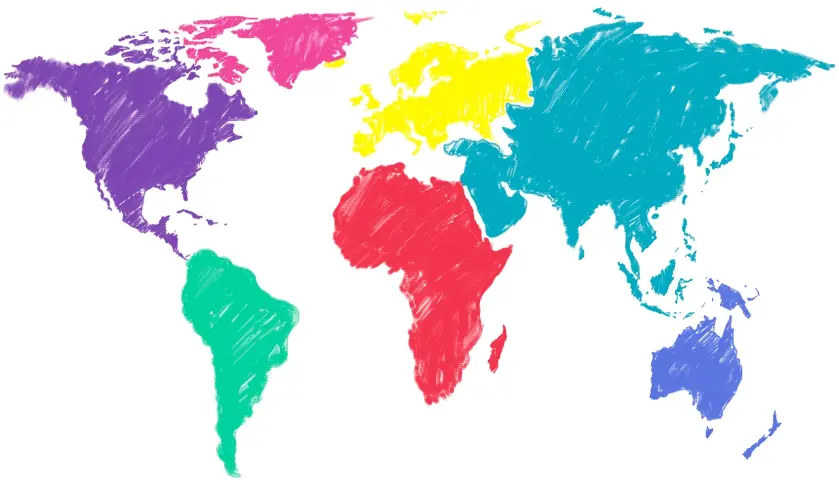
3. Let us do – On the outline map of the world given below, label all the continents and oceans.
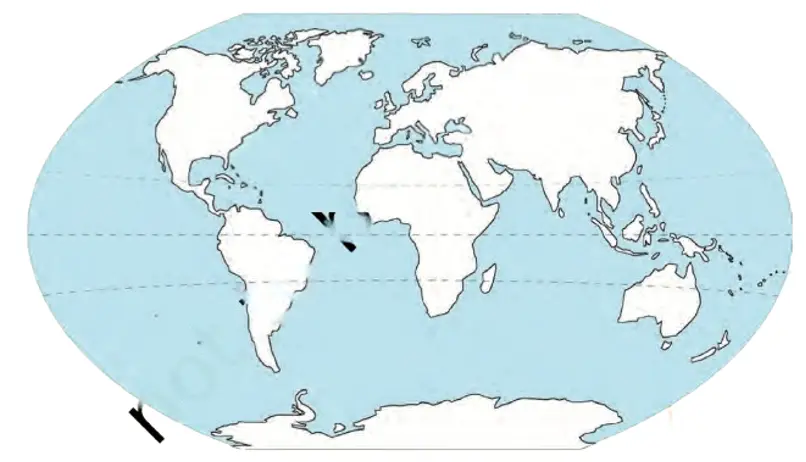
Answer:
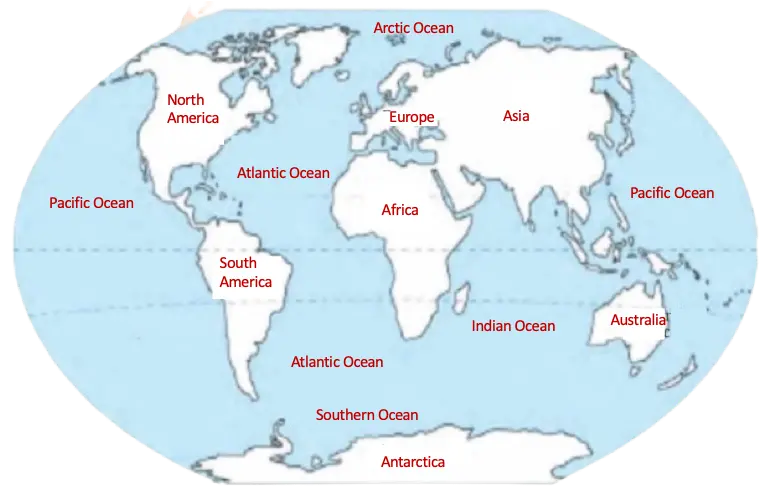
4. Solve this crossword
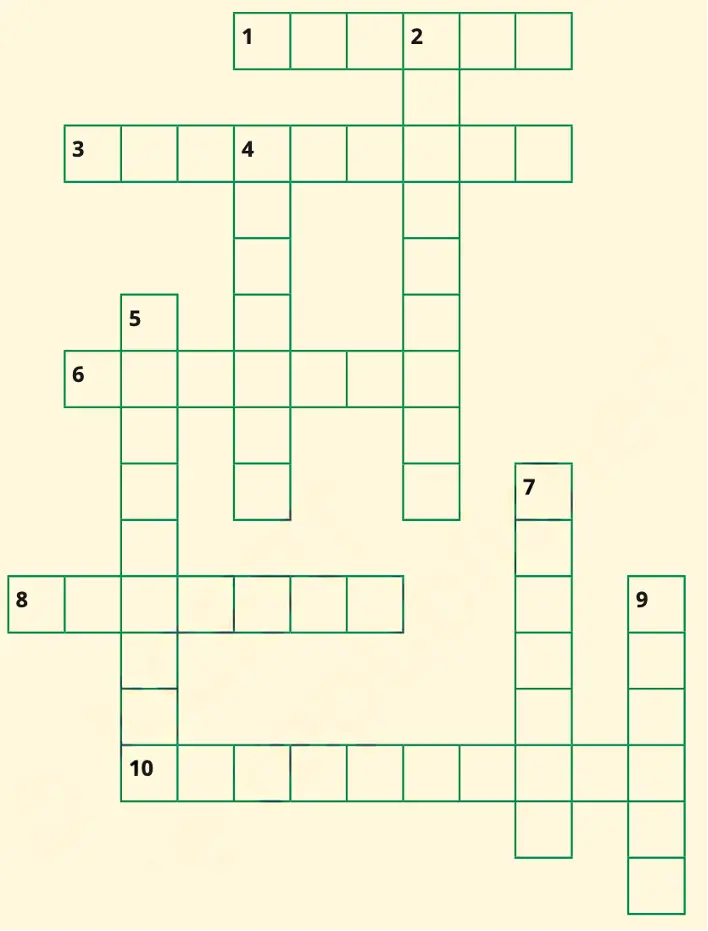
| Across | Down |
| 1. Abundantly produced by the oceans | 2. The largest island on Earth |
| 3. A large expanse of landmass | 4. A huge destructive wave from the ocean |
| 6. A large continent of which India is a part | 5. The smallest continent |
| 8. A major source of pollution of the oceans | 7. The largest body of water on the Earth |
| 10. The coldest continent | 9. A landmass (but not a continent) surrounded by the sea or ocean |
Answer:
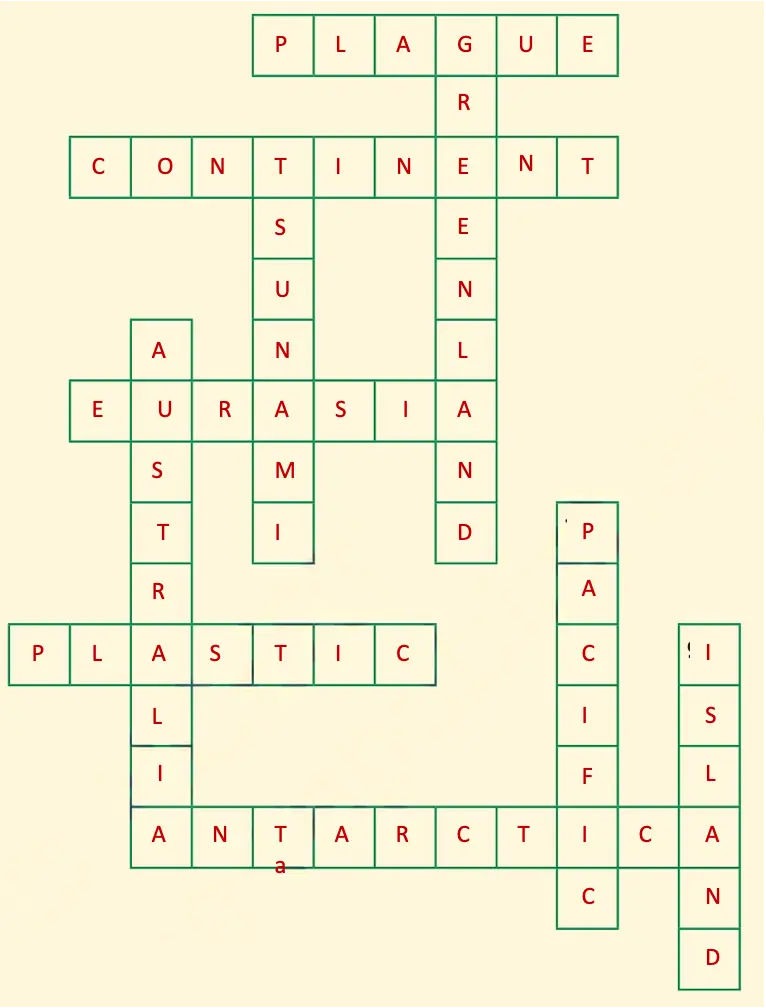
| Across | Down |
| 1. Abundantly produced by the oceans – Plague | 2. The largest island on Earth – Greenland |
| 3. A large expanse of landmass – Continent | 4. A huge destructive wave from the ocean – Tsunami |
| 6. A large continent of which India is a part – Eurasia | 5. The smallest continent – Australia |
| 8. A major source of pollution of the oceans – Plastic | 7. The largest body of water on the Earth – Pacific |
| 10. The coldest continent – Antarctica | 9. A landmass (but not a continent) surrounded by the sea or ocean – Island. |
